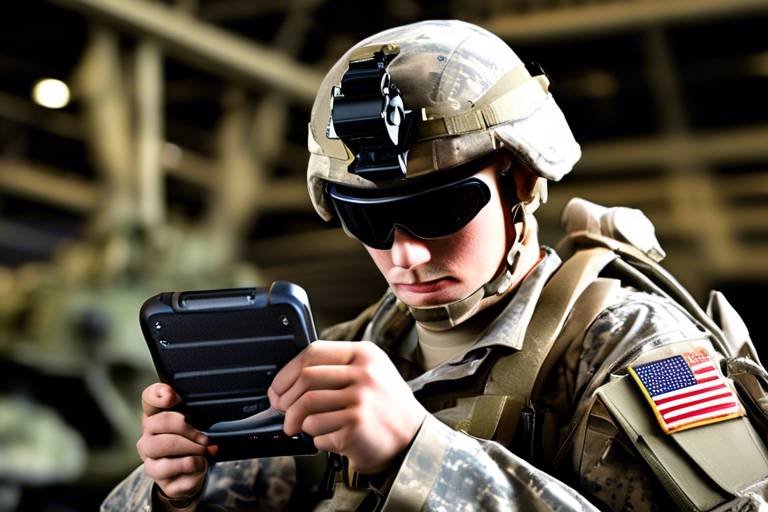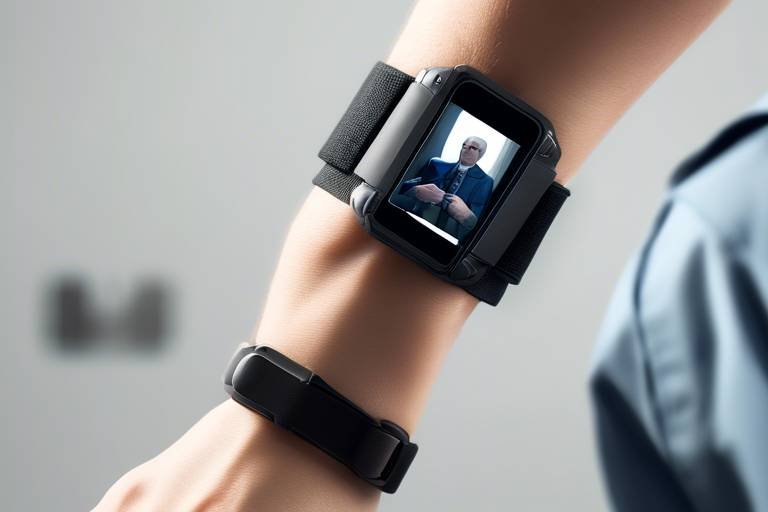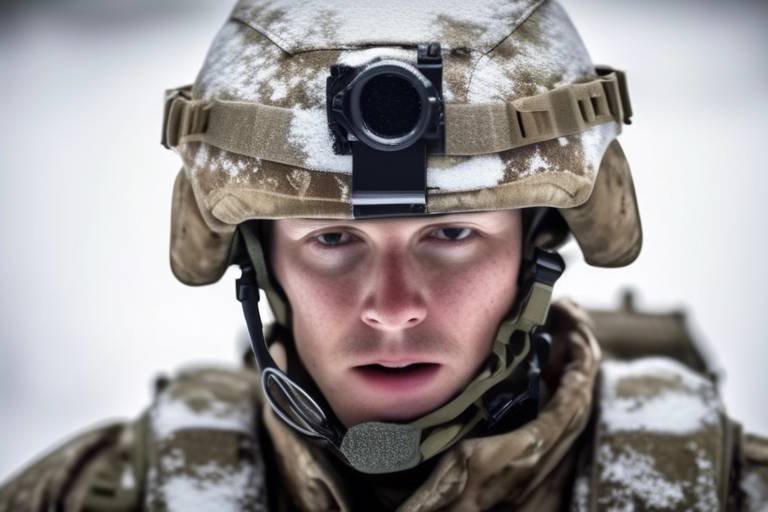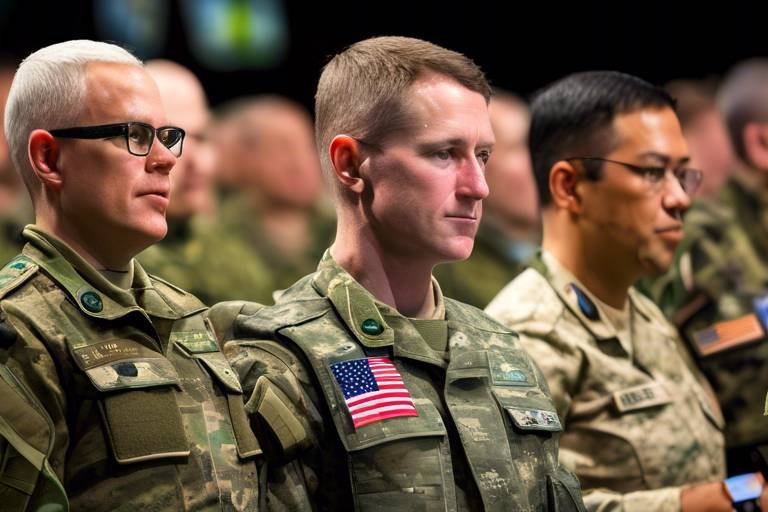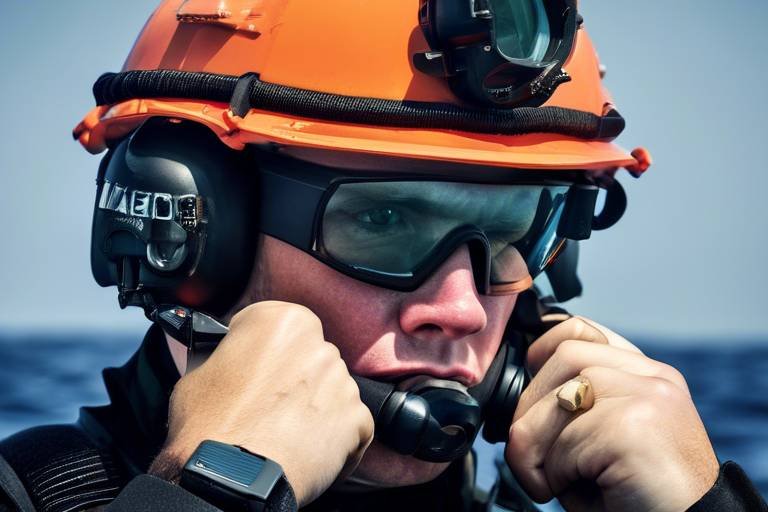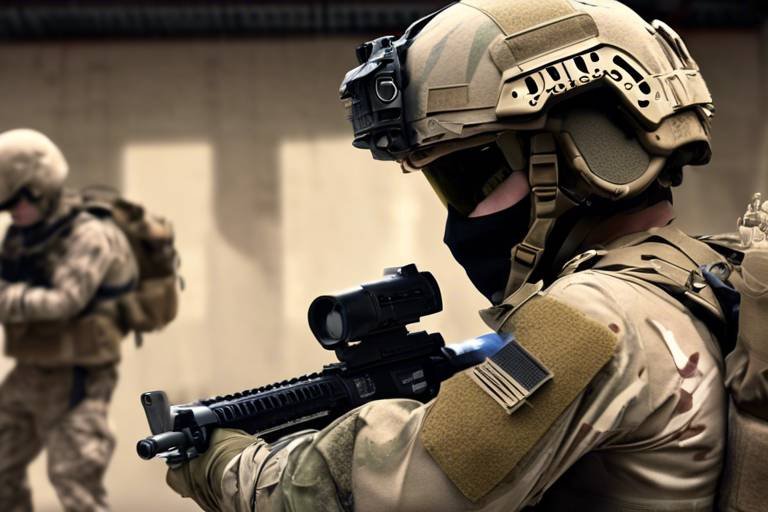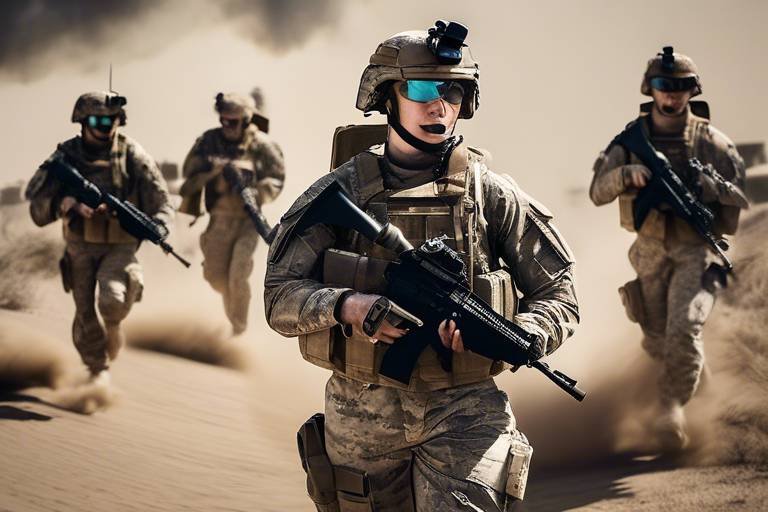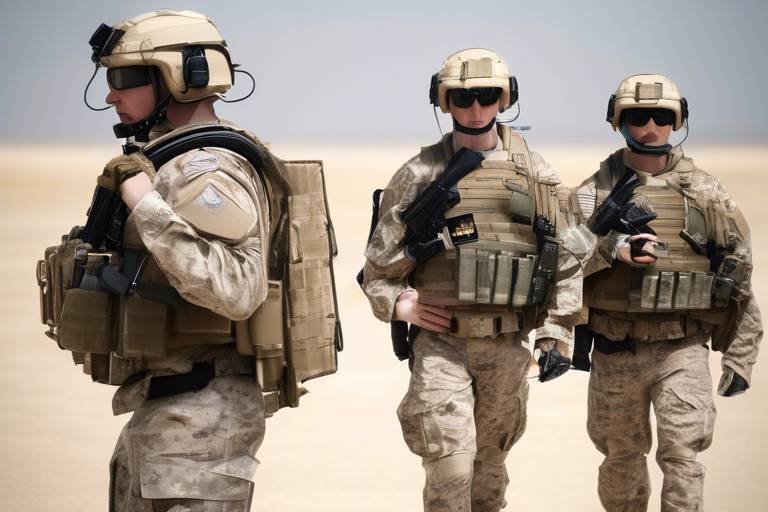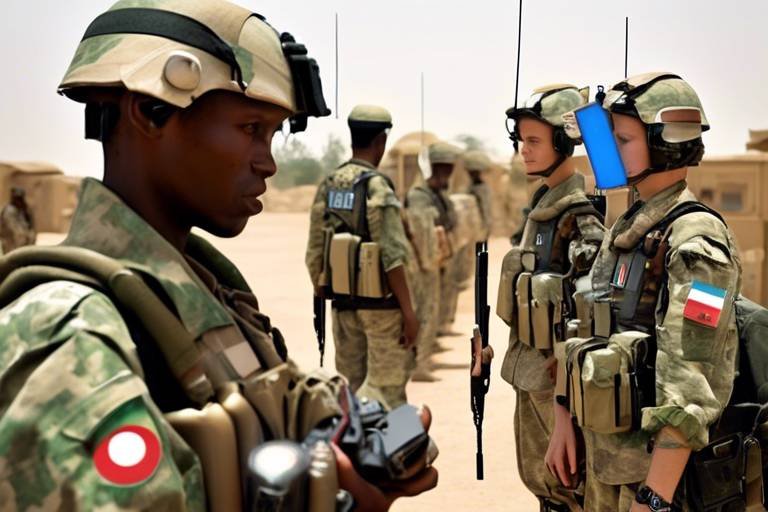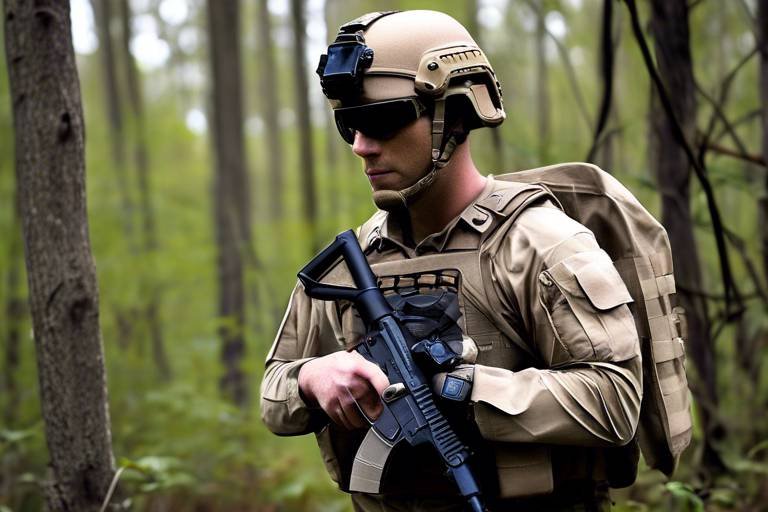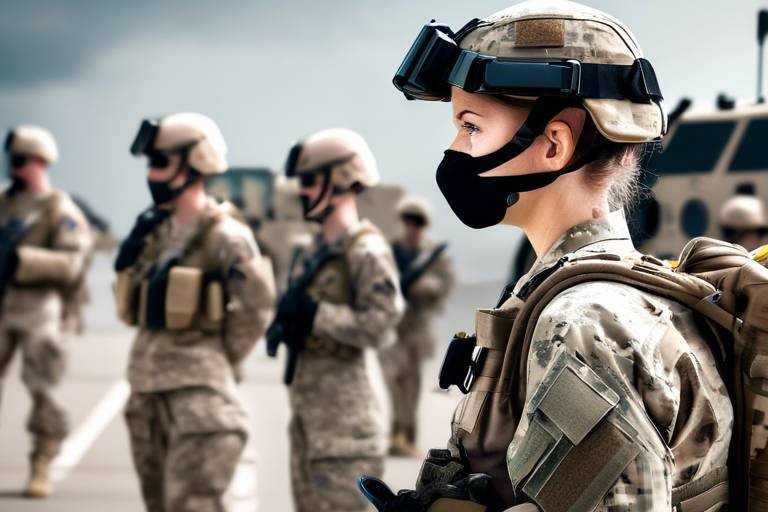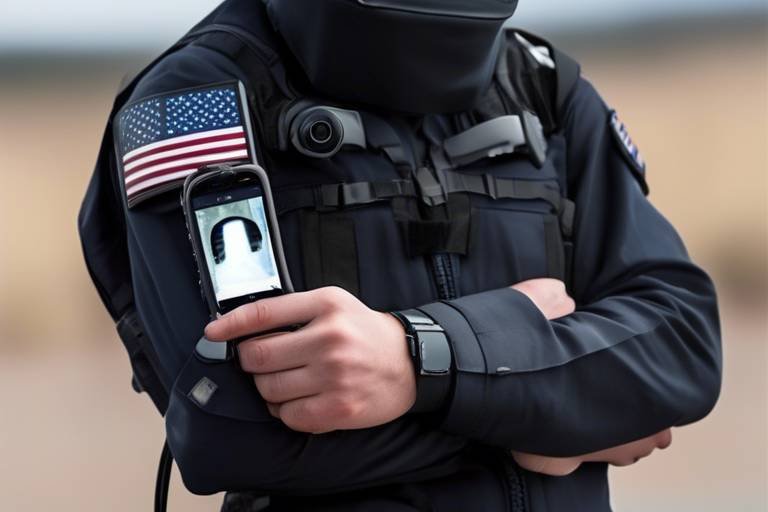The Integration of Wearable Tech in Military Procurement Processes
In recent years, the military has been undergoing a dramatic transformation, and at the heart of this revolution lies wearable technology. This innovative tech is not just a trend; it’s reshaping how military procurement processes operate, enhancing operational efficiency, and ultimately improving soldier safety. Imagine a world where soldiers are equipped with devices that can monitor their health and provide crucial data in real-time. This is not science fiction; this is the new reality of military operations. As we delve deeper into this topic, we'll uncover how wearable technology is making waves in military procurement and why it matters.
Wearable technology is becoming increasingly crucial in military operations. It provides real-time data that enhances situational awareness, improves decision-making, and increases overall mission effectiveness for soldiers on the ground. Picture this: a soldier in the field receives instant updates about their surroundings, allowing them to make informed choices that could mean the difference between success and failure. The integration of these devices is not merely about convenience; it’s about survival. With wearable tech, the military can ensure that personnel are better informed, making them more effective in their roles.
The integration of wearable devices in procurement processes offers numerous benefits that are hard to ignore. For starters, these devices streamline operations, enhance communication, and improve tracking of inventory and equipment. This leads to more efficient resource management. Imagine a scenario where every piece of equipment is tracked in real-time, ensuring that nothing goes missing and everything is maintained properly. This level of oversight can significantly reduce costs and improve operational readiness.
One of the standout features of wearable technology is its ability to enable real-time data collection. This capability allows military personnel to monitor equipment status and soldier health continuously. For instance, if a soldier is experiencing fatigue or stress, commanders can receive alerts that facilitate timely decisions. This proactive approach can significantly impact mission success and safety. In a dynamic battlefield environment, having the right information at the right time is invaluable.
Advanced wearable devices come equipped with health monitoring capabilities that track vital signs, fatigue levels, and stress indicators. This data provides commanders with critical health insights, helping to ensure the well-being of personnel during demanding missions. Consider this: a soldier on the front lines can wear a device that monitors their heart rate and stress levels. If the device indicates that they are nearing a dangerous level of fatigue, immediate action can be taken to ensure their safety. This is a game-changer in personnel management and operational effectiveness.
Wearable technology also excels in equipment tracking. These devices can monitor equipment usage and performance, enabling better maintenance schedules and reducing downtime. Imagine a situation where equipment failures are minimized because the devices alert maintenance teams about potential issues before they escalate. This proactive maintenance approach leads to enhanced operational readiness and efficiency, ensuring that military units are always prepared for action.
Another significant advantage of wearable technology is its ability to improve communication among military personnel. In complex operations, ensuring that vital information is shared quickly and efficiently is essential. Wearable devices facilitate this communication, allowing soldiers to stay connected and coordinated. Think of it as a high-tech version of a walkie-talkie, but with the added benefits of data sharing and real-time updates. This level of connectivity can be the key to successful operations, especially in high-stakes environments.
While the benefits are compelling, integrating wearable technology into military procurement processes is not without its challenges. Issues such as cybersecurity risks, interoperability challenges, and the need for comprehensive training must be addressed to ensure successful integration. It’s essential to recognize that with great technology comes great responsibility. The military must be vigilant in protecting sensitive data and ensuring that personnel are well-equipped to use these devices effectively.
The use of wearable devices raises significant cybersecurity concerns. Sensitive data can be vulnerable to hacking, necessitating robust security measures to protect military information and personnel. Imagine the consequences if a hacker gains access to critical information during a mission. The stakes are incredibly high, making cybersecurity a top priority in the integration of wearable tech.
Moreover, ensuring that different wearable technologies can work together seamlessly is crucial for effective integration. Interoperability challenges can hinder communication and data sharing among various military units, potentially compromising mission effectiveness. It’s like trying to fit together puzzle pieces from different sets; without compatibility, the picture remains incomplete.
The future of wearable technology in the military looks promising. Advancements in artificial intelligence, augmented reality, and miniaturization are expected to further enhance capabilities and streamline procurement processes. As these technologies evolve, we can anticipate even more innovative applications that will revolutionize how the military operates. The integration of these technologies is not just about keeping pace with the times; it’s about leading the way into a new era of military effectiveness.
- What is wearable technology in the military? Wearable technology in the military refers to devices that can be worn by soldiers to monitor health, track equipment, and enhance communication.
- How does wearable tech improve soldier safety? By providing real-time health monitoring and situational awareness, wearable tech helps ensure that soldiers are safe and can make informed decisions.
- What are the challenges of integrating wearable tech? Key challenges include cybersecurity risks, interoperability issues, and the need for proper training.
- What does the future hold for wearable technology in the military? The future includes advancements in AI, augmented reality, and miniaturization, which will enhance military capabilities further.
The Role of Wearable Technology in Military Operations
Wearable technology is rapidly becoming a game-changer in military operations, providing soldiers with cutting-edge tools that enhance their performance on the battlefield. Imagine being a soldier equipped with a device that not only tracks your physical condition but also provides real-time data about your surroundings. This is not science fiction; it's the reality of modern military tech. These devices, ranging from smart helmets to health-monitoring wearables, are designed to improve situational awareness, boost decision-making skills, and ultimately increase mission effectiveness.
One of the most significant advantages of wearable technology is its ability to deliver real-time data. Soldiers can access critical information about their environment, including enemy positions, weather conditions, and even the status of their own equipment, all at a glance. This immediacy allows for quicker reactions to unforeseen circumstances, which can mean the difference between success and failure in high-stakes situations. For instance, a soldier equipped with an augmented reality headset can receive live updates on troop movements, enabling them to adapt their strategies on the fly.
Moreover, wearable technology enhances communication among military personnel. In the heat of battle, every second counts, and having a reliable way to share information is crucial. Wearable devices can facilitate instant messaging, voice commands, and even video feeds, ensuring that soldiers remain connected regardless of their physical location. This seamless communication is essential for coordinating complex operations where multiple units must work together effectively.
To illustrate the impact of wearable tech, consider the following table that summarizes key features and benefits:
| Feature | Benefit |
|---|---|
| Health Monitoring | Tracks vital signs and fatigue levels, ensuring soldier well-being. |
| Real-Time Data Access | Provides immediate information on environmental and equipment status. |
| Enhanced Communication | Facilitates rapid information sharing among units. |
| Augmented Reality Interfaces | Offers visual overlays of tactical information for better situational awareness. |
In addition to these benefits, wearable technology also plays a crucial role in training and preparedness. Soldiers can use simulated scenarios to practice their skills while receiving feedback from their wearable devices. This data-driven approach not only enhances individual performance but also fosters a culture of continuous improvement within military units.
In conclusion, the integration of wearable technology into military operations is not just a trend; it's a necessity for modern warfare. By providing soldiers with the tools they need to monitor their health, communicate effectively, and access real-time information, wearable tech is paving the way for a new era of military efficiency and effectiveness.
- What types of wearable technology are used in the military? Wearable technology in the military includes smart helmets, fitness trackers, augmented reality devices, and health-monitoring systems.
- How does wearable technology improve soldier safety? By monitoring vital signs and providing real-time data, wearable tech helps identify health issues and enhances situational awareness, ultimately improving soldier safety.
- Are there any cybersecurity concerns with wearable technology? Yes, wearable devices can be vulnerable to hacking, which is why robust cybersecurity measures are essential to protect sensitive military data.
- What is the future of wearable technology in military operations? The future looks promising, with advancements in AI, augmented reality, and miniaturization expected to enhance capabilities further.
Benefits of Wearable Devices in Procurement
The integration of wearable devices in military procurement processes is not just a trend; it’s a game changer. These innovative gadgets are enhancing the way military operations are conducted, leading to a more streamlined and efficient workflow. Imagine soldiers equipped with smart technology that not only tracks their health but also manages their gear in real-time. This dual functionality is revolutionizing how procurement is approached in the military sector.
One of the most significant benefits of wearable technology is the streamlined operations. With devices that can monitor everything from equipment status to soldier health, procurement teams can make informed decisions faster than ever. For instance, if a soldier’s wearable device indicates fatigue or stress, commanders can quickly adjust assignments to ensure personnel are fit for duty. This proactive approach not only enhances the well-being of the troops but also optimizes mission effectiveness.
Additionally, these devices facilitate enhanced communication among military personnel. Imagine a scenario where information is shared instantaneously, without the usual delays associated with traditional communication methods. Wearable technology allows for seamless communication, ensuring that every team member is on the same page. This is especially crucial during complex operations where timing and coordination can mean the difference between success and failure.
Moreover, the improved tracking of inventory and equipment cannot be overlooked. Wearable devices can provide real-time updates on the status of gear, which means procurement teams can easily monitor usage and performance. This leads to better maintenance schedules, reducing downtime and ensuring that equipment is always ready for action. With the ability to track items efficiently, the military can reduce waste and improve resource management significantly.
To illustrate the impact of these benefits, consider the following table that summarizes key advantages of wearable devices in military procurement:
| Benefit | Description |
|---|---|
| Streamlined Operations | Real-time monitoring allows for quick adjustments in personnel assignments based on health data. |
| Enhanced Communication | Instant information sharing improves coordination during missions. |
| Improved Tracking | Real-time inventory updates lead to better maintenance and resource management. |
In conclusion, the benefits of integrating wearable devices into military procurement processes are vast and impactful. By enhancing operational efficiency, improving communication, and providing real-time data, these devices are not just tools; they are essential components of modern military strategy. As technology continues to evolve, the military's ability to adapt and integrate these advancements will only strengthen its operational capabilities.
- What types of wearable devices are used in military operations? Wearable devices can include smartwatches, health monitors, and augmented reality glasses, all designed to enhance soldier performance and safety.
- How do wearable devices improve soldier safety? By monitoring vital signs and stress levels, wearable technology can alert commanders to potential health issues, allowing for timely intervention.
- What challenges are associated with integrating wearable technology? Key challenges include cybersecurity risks, interoperability issues, and the need for training personnel to use these devices effectively.
Real-Time Data Collection
In the fast-paced world of military operations, is not just a luxury; it's a necessity. Imagine being on the ground, surrounded by chaos, and having the ability to receive live updates about your equipment's status or the health of your fellow soldiers. This is where wearable technology steps in, acting as a lifeline that connects soldiers to critical information at a moment's notice. With devices that can monitor a variety of metrics, the military can make informed decisions that directly impact mission success.
Wearable tech, such as smart helmets and health-monitoring wristbands, is equipped with sensors that continuously gather data. These devices can track vital signs like heart rate, body temperature, and even movement patterns. For instance, if a soldier's heart rate spikes unexpectedly, commanders can be alerted to potential health risks, allowing for immediate intervention. This capability is crucial in high-stress environments where every second counts.
Moreover, the integration of wearable devices with existing military systems enhances operational efficiency. Through cloud connectivity, data collected by wearables can be transmitted in real-time to command centers, providing a comprehensive overview of the battlefield. This synergy allows decision-makers to assess situations dynamically, adapting strategies as conditions change. For example, if equipment malfunctions are detected through wearables, maintenance teams can be dispatched promptly, minimizing downtime and ensuring that resources are always available when needed.
To illustrate the significance of real-time data collection, consider the following table that outlines key metrics monitored by wearable technology:
| Metric | Importance | Impact on Operations |
|---|---|---|
| Heart Rate | Indicates stress levels and physical exertion | Helps in assessing soldier readiness and health |
| Body Temperature | Monitors for heat stress or hypothermia | Ensures timely medical intervention |
| Location Tracking | Provides real-time positioning of personnel | Aids in coordination and rescue operations |
In conclusion, the integration of wearable technology for real-time data collection is revolutionizing military operations. It empowers soldiers with critical insights that enhance their safety and effectiveness. As these technologies continue to evolve, the potential for improved decision-making and operational success will only grow, paving the way for a more efficient and responsive military force.
- What types of wearable technology are used in the military? Wearable technology in the military includes smart helmets, health-monitoring wristbands, and body cameras, all designed to enhance situational awareness and soldier safety.
- How does real-time data collection improve mission effectiveness? By providing live updates on soldier health and equipment status, commanders can make informed decisions quickly, adapting strategies to changing conditions on the battlefield.
- What are the cybersecurity risks associated with wearable technology? Wearable devices can be vulnerable to hacking, which poses risks to sensitive military data. Robust security measures are essential to protect this information.
- Will wearable technology replace traditional military equipment? While wearable technology enhances existing equipment, it is unlikely to replace traditional military gear entirely. Instead, it will complement and improve the functionality of current systems.
Health Monitoring Capabilities
In the high-stakes world of military operations, where every second counts and the safety of personnel is paramount, offered by wearable technology have emerged as a game-changer. Imagine a soldier in the field, equipped with a device that continuously tracks their vital signs, fatigue levels, and even stress indicators. This technology not only provides real-time health data but also empowers commanders to make informed decisions that can significantly impact the well-being of their troops.
Wearable devices can monitor various health metrics, including:
- Heart Rate: Continuous tracking of heart rate can alert commanders to potential health issues, enabling timely interventions.
- Body Temperature: Monitoring body temperature helps in identifying signs of heat stress or hypothermia, critical in extreme environments.
- Sleep Patterns: Understanding a soldier's sleep quality can help in managing fatigue, ensuring they are fit for duty.
- Stress Levels: Advanced sensors can assess stress through physiological markers, allowing for proactive mental health support.
These capabilities are essential for maintaining operational readiness. For instance, if a soldier's heart rate spikes unexpectedly during a mission, commanders can quickly assess the situation and provide necessary support or even call for a medical evacuation if needed. Furthermore, the data collected from these devices can be aggregated and analyzed, providing insights into the overall health trends of units over time. This information can be invaluable for adjusting training regimens and ensuring that soldiers are physically and mentally prepared for the challenges they face.
Moreover, the integration of these health monitoring systems into military operations not only enhances individual soldier safety but also fosters a culture of health awareness within military units. By prioritizing health and wellness, the military can improve morale and effectiveness, ultimately leading to better mission outcomes. The potential of wearable technology in health monitoring is vast, and as these devices continue to evolve, they will undoubtedly play an increasingly critical role in safeguarding the lives of those who serve.
Q1: How do wearable devices ensure the safety of soldiers?
A1: Wearable devices monitor vital signs and health metrics, allowing commanders to make informed decisions about soldier readiness and health, facilitating timely interventions when necessary.
Q2: Can wearable tech track mental health indicators?
A2: Yes, advanced wearable devices can assess stress levels through physiological markers, providing insights that help in managing mental health during demanding missions.
Q3: What are the challenges of implementing health monitoring technology?
A3: Challenges include ensuring cybersecurity to protect sensitive data, achieving interoperability among different devices, and training personnel to effectively use and understand the technology.
Q4: How does health monitoring impact military training?
A4: By analyzing health data, military leaders can adjust training programs to better fit the needs of soldiers, enhancing overall readiness and performance.
Equipment Tracking
In the fast-paced world of military operations, has transformed into a vital component for maintaining operational efficiency and readiness. Imagine a scenario where soldiers are deployed in a remote area, and every piece of equipment they rely on is meticulously monitored in real-time. This is where wearable technology steps in, allowing for a seamless connection between personnel and their gear. With advanced sensors integrated into uniforms or accessories, military units can now track the usage and performance of equipment like never before.
Wearable devices equipped with GPS and telemetry systems can provide invaluable insights into how equipment is being utilized. For instance, if a soldier is using a specific piece of machinery, the wearable can record data such as operational hours, wear and tear, and even environmental conditions. This information can then be relayed back to command centers, enabling commanders to make informed decisions about maintenance schedules and resource allocation. The ability to foresee potential equipment failures before they occur not only enhances operational readiness but also significantly reduces downtime.
Furthermore, the integration of wearable technology aids in establishing a comprehensive inventory management system. By automating the tracking process, military units can maintain accurate records of all equipment on hand. This minimizes the risk of loss or misplacement, which can be detrimental during critical missions. With a clear view of what is available and what is needed, procurement processes can be streamlined to ensure that soldiers always have access to the tools they require.
To illustrate the impact of effective equipment tracking, consider the following table that outlines the benefits of integrating wearable technology in military logistics:
| Benefit | Description |
|---|---|
| Enhanced Maintenance | Real-time data on equipment usage helps schedule maintenance proactively. |
| Increased Accountability | Tracking equipment ensures that all items are accounted for, reducing loss. |
| Operational Readiness | Improved monitoring leads to higher availability of equipment when needed. |
In summary, the use of wearable technology for equipment tracking not only promotes efficiency but also enhances the safety and effectiveness of military operations. By enabling real-time monitoring and proactive maintenance, these innovations ensure that soldiers are always equipped with reliable gear, ready to face any challenge that comes their way.
- What types of wearable technology are used in military operations?
Wearable technology in military operations includes smartwatches, fitness trackers, and specialized uniforms equipped with sensors that monitor health and equipment status.
- How does wearable technology improve soldier safety?
By providing real-time health monitoring and equipment tracking, wearable technology helps ensure that soldiers are aware of their physical condition and the status of their gear, allowing for timely interventions when necessary.
- What are the challenges in implementing wearable technology in the military?
Challenges include cybersecurity risks, ensuring interoperability among various devices, and the need for adequate training for personnel on how to use these technologies effectively.
Enhanced Communication Systems
In the fast-paced world of military operations, communication can be the difference between mission success and failure. Wearable technology is stepping up to the plate, transforming how military personnel share information on the battlefield. Imagine a scenario where soldiers are equipped with smart helmets or wrist devices that not only provide critical data but also facilitate instant communication with their command centers. These devices allow for seamless, real-time updates that enhance situational awareness and operational coordination.
One of the standout features of wearable technology is its ability to integrate advanced communication systems. For instance, soldiers can receive voice commands or alerts directly through their wearables, reducing the need to rely on traditional communication devices that can be bulky and cumbersome. This streamlined communication ensures that vital information flows quickly and efficiently, which is crucial during high-stakes situations. Furthermore, the ability to communicate hands-free allows soldiers to maintain their focus on the task at hand, significantly improving their effectiveness in the field.
Moreover, these wearable devices are equipped with GPS tracking capabilities, enabling commanders to monitor troop movements in real-time. This feature not only enhances coordination among units but also improves the overall safety of personnel. By having a clear picture of where each soldier is located, commanders can make informed decisions, allocate resources effectively, and respond swiftly to any emerging threats.
To illustrate the impact of enhanced communication systems through wearable technology, consider the following table:
| Feature | Benefit |
|---|---|
| Real-time Updates | Improves situational awareness and decision-making |
| Hands-free Communication | Allows soldiers to focus on their tasks without distraction |
| GPS Tracking | Enhances safety and coordination among units |
Furthermore, the integration of wearable technology fosters a culture of collaboration and teamwork among military units. With improved communication, soldiers can share intelligence and updates on enemy movements or environmental changes, creating a more cohesive operational strategy. This sense of unity is vital, especially in complex missions where every second counts.
In summary, the incorporation of wearable technology into military communication systems is not just a trend; it is a revolutionary change that enhances operational efficiency and soldier safety. As these technologies continue to evolve, we can expect even more innovative solutions that will further streamline communication and improve the effectiveness of military operations.
- What are the main advantages of using wearable technology in military operations?
Wearable technology enhances situational awareness, improves communication, and provides real-time data, ultimately leading to more effective mission execution. - How does wearable technology improve communication among soldiers?
Wearable devices allow for hands-free communication, instant updates, and GPS tracking, which helps maintain coordination and safety during operations. - Are there any security concerns with using wearable technology in the military?
Yes, cybersecurity is a significant concern, as sensitive data transmitted through these devices can be vulnerable to hacking, necessitating robust security measures.
Challenges in Integrating Wearable Tech
While the integration of wearable technology into military procurement processes offers numerous advantages, it is not without its challenges. One of the primary hurdles is cybersecurity. As these devices collect and transmit sensitive data, they become potential targets for cyberattacks. Imagine a scenario where an enemy intercepts critical information regarding troop movements or equipment status due to inadequate security measures. This not only compromises operational security but can also jeopardize the safety of personnel on the ground. Therefore, it is essential for military organizations to implement robust security protocols that protect against unauthorized access and data breaches.
Another significant challenge is interoperability. The military often employs a variety of technologies, and ensuring that different wearable devices can communicate seamlessly is crucial for effective operations. If one unit uses a specific brand of wearable technology that cannot exchange data with another unit's system, it can create a communication breakdown during critical moments. This is particularly problematic in complex operations where coordination among various units is vital. Thus, manufacturers and military procurement officials must prioritize compatibility and standardization in their technology choices.
Additionally, the need for training cannot be overlooked. Even the most advanced technology is only as good as the personnel who operate it. Soldiers must be adequately trained not only on how to use these devices but also on understanding the data they provide. This training needs to be comprehensive and ongoing, as technology evolves rapidly. A well-trained soldier who can interpret real-time data effectively will make more informed decisions, ultimately enhancing mission success. However, the challenge lies in providing this training amidst the already demanding schedules of military personnel.
In summary, while the benefits of integrating wearable technology into military procurement processes are substantial, addressing these challenges is crucial for successful implementation. The military must navigate the complexities of cybersecurity, interoperability, and training to fully leverage the potential of wearable devices.
- What are the main cybersecurity risks associated with wearable technology in the military?
Cybersecurity risks include unauthorized access to sensitive data, potential hacking of devices, and the interception of critical communication. Robust security measures are essential to mitigate these risks.
- How can interoperability issues be resolved?
Interoperability can be improved through standardization of technology and ensuring that all devices used across various military units can communicate effectively.
- What kind of training is needed for military personnel using wearable tech?
Training should focus on the operational use of the devices, data interpretation, and understanding the technology's capabilities and limitations.
Cybersecurity Concerns
As the military increasingly integrates wearable technology into its operations, the issue of cybersecurity cannot be overlooked. With sensitive data being transmitted and stored, the potential for hacking and data breaches becomes a pressing concern. Imagine a scenario where a soldier's health data or mission-critical information falls into the wrong hands; the consequences could be catastrophic. The reliance on wireless communication channels makes these devices particularly vulnerable to cyber threats, which can compromise both operational integrity and soldier safety.
To mitigate these risks, military organizations must implement robust security measures that include encryption protocols, secure authentication methods, and regular software updates. It's similar to locking the doors and windows of your house; without proper security, any intruder can gain access. Furthermore, the military must foster a culture of cybersecurity awareness among personnel, ensuring that everyone understands the importance of safeguarding sensitive information.
In addition to these measures, the military should consider the following key strategies to enhance cybersecurity in wearable technology:
- Regular Security Audits: Conducting frequent assessments can help identify vulnerabilities before they are exploited.
- Data Encryption: Ensuring that all data transmitted from wearable devices is encrypted can significantly reduce the risk of interception.
- Training Programs: Providing ongoing training for military personnel on cybersecurity best practices is essential for maintaining security standards.
Moreover, the integration of advanced technologies such as artificial intelligence can play a pivotal role in enhancing cybersecurity. AI can be used to detect unusual patterns of behavior that may indicate a security breach, allowing for swift action to be taken. As the military moves forward with wearable tech, prioritizing cybersecurity will be crucial not just for protecting information but also for maintaining trust among personnel and ensuring mission success.
- What are the main cybersecurity risks associated with wearable technology in the military?
The primary risks include data breaches, unauthorized access to sensitive information, and potential hacking of devices that could compromise operational effectiveness.
- How can the military enhance cybersecurity for wearable devices?
By implementing strong encryption, conducting regular security audits, and providing thorough training on cybersecurity awareness for personnel.
- What role does AI play in improving cybersecurity for wearable technology?
AI can help detect unusual behavior patterns and potential threats, allowing for quicker responses to security incidents.
Interoperability Issues
Integrating wearable technology into military operations is not without its challenges, and one of the most pressing issues is interoperability. As various branches of the military adopt different wearable devices, the ability for these technologies to communicate and function together seamlessly becomes essential. Imagine a scenario where soldiers equipped with advanced health-monitoring wearables struggle to share vital data with their counterparts using different systems. This can lead to miscommunication, delayed responses, and potentially jeopardize mission success.
Interoperability issues arise primarily due to the following factors:
- Diverse Technologies: Different manufacturers produce wearable tech with varying standards and protocols, making it challenging to ensure compatibility.
- Data Formats: The information collected by wearables may be formatted differently, which complicates data sharing and analysis.
- Legacy Systems: Many military units still rely on outdated technology that may not support the latest wearable devices, creating a gap in functionality.
To address these interoperability issues, military procurement processes must prioritize the selection of devices that adhere to common standards. This means fostering partnerships with tech companies that are willing to develop solutions that can integrate with existing systems. Additionally, establishing a unified communication protocol can significantly enhance the ability of different devices to work together. By investing in research and development, the military can create a more cohesive technological ecosystem that ultimately supports soldiers on the ground.
Furthermore, training personnel to understand and utilize these technologies effectively is crucial. If soldiers are not well-versed in how to operate their devices or share data with others, the potential benefits of these wearables can be lost. Therefore, military training programs should incorporate modules focused on the use of wearable technology, emphasizing the importance of interoperability in enhancing operational efficiency.
In conclusion, while the integration of wearable technology holds immense promise for military operations, addressing interoperability issues is vital. By ensuring that different systems can communicate effectively, the military can enhance situational awareness, streamline operations, and ultimately improve mission outcomes.
- What is interoperability in the context of military wearables? Interoperability refers to the ability of various wearable devices to communicate and function together seamlessly, ensuring that data can be shared and utilized effectively across different systems.
- Why is interoperability important for military operations? It is crucial because it enhances communication and coordination among military units, allowing for real-time data sharing that can impact mission success.
- What are some challenges to achieving interoperability? Challenges include diverse technologies from different manufacturers, varying data formats, and the presence of legacy systems that may not support new devices.
- How can the military improve interoperability among wearable devices? By prioritizing the selection of devices that adhere to common standards, establishing unified communication protocols, and providing thorough training for personnel.
Future Trends in Wearable Technology for Military Use
The future of wearable technology in military applications is not just bright; it's practically glowing with potential. As we look ahead, several trends are emerging that promise to transform how military forces operate and procure resources. Imagine a battlefield where soldiers are equipped with smart helmets that provide real-time data feeds, or wristbands that monitor their health and fatigue levels continuously. These innovations aren't just concepts; they're on the cusp of becoming reality. With advancements in artificial intelligence (AI), augmented reality (AR), and the miniaturization of tech, the integration of wearables into military operations is set to become more sophisticated and effective.
One of the most exciting trends is the incorporation of AI algorithms into wearable devices. These algorithms can analyze data collected from soldiers in real-time, offering insights that can lead to better decision-making on the ground. For instance, AI can predict when a soldier might be at risk of exhaustion based on their physiological data, allowing commanders to adjust missions proactively. This capability not only enhances soldier safety but also ensures that missions are executed with optimal effectiveness.
Augmented reality is another game-changer. Imagine soldiers wearing smart glasses that overlay critical information directly onto their field of vision. This technology can provide navigation aids, enemy locations, and even tactical suggestions without the need to divert attention from the mission. The ability to see essential data while maintaining situational awareness could drastically reduce response times and improve coordination in complex scenarios.
Moreover, the miniaturization of wearable devices is paving the way for even more innovative applications. As technology shrinks, we can expect to see more discreet devices that can be integrated into everyday military gear. This means that soldiers can benefit from advanced technology without compromising their mobility or comfort. For example, tiny sensors embedded in uniforms could monitor environmental conditions and alert soldiers to potential hazards such as chemical exposure or extreme temperatures.
However, with these advancements come challenges that must be addressed. The military will need to ensure that these technologies are secure, reliable, and user-friendly. The integration of wearables into existing systems must be seamless, requiring collaboration between technology developers and military procurement teams. Additionally, as these devices collect vast amounts of data, robust cybersecurity measures will be essential to protect sensitive information.
In conclusion, the future of wearable technology in military use is poised for a revolution. With the combination of AI, AR, and miniaturization, we are looking at a landscape where soldiers are not only safer but also more efficient and effective in their missions. As we embrace these technologies, the military procurement process will also evolve, ensuring that our troops have the best tools available to face the challenges of modern warfare.
- What types of wearable technology are currently used in the military?
Wearable technology in the military includes health monitoring devices, smart helmets with augmented reality features, and GPS-enabled gear for navigation and communication. - How does wearable technology enhance soldier safety?
Wearable devices can monitor vital signs and fatigue levels, alerting commanders to potential health risks and allowing for timely interventions. - What are the cybersecurity concerns associated with wearable technology?
Wearable devices can be vulnerable to hacking, which poses a risk to sensitive military data. Robust security measures are necessary to mitigate these risks. - Will wearable technology be integrated into existing military systems?
Yes, successful integration will require collaboration between tech developers and military procurement teams to ensure interoperability and user-friendliness.
Frequently Asked Questions
- What is wearable technology in military operations?
Wearable technology refers to devices that can be worn on the body, such as smartwatches and health monitors. In military operations, these devices provide real-time data that enhances situational awareness, improves decision-making, and increases overall mission effectiveness for soldiers on the ground.
- How does wearable tech improve military procurement processes?
Wearable technology streamlines procurement processes by enhancing communication, improving inventory tracking, and facilitating real-time data collection. This leads to more efficient resource management and helps ensure that the right equipment is available when needed.
- What are the health monitoring capabilities of wearable devices?
Advanced wearable devices can monitor various health metrics, including vital signs, fatigue levels, and stress indicators. This information is crucial for commanders, as it helps ensure the well-being of personnel during demanding missions and allows for timely interventions when necessary.
- What challenges are associated with integrating wearable technology?
Integrating wearable technology in military procurement faces challenges like cybersecurity risks, interoperability issues, and the need for specialized training. Addressing these concerns is essential for successful implementation and to protect sensitive military data.
- How can cybersecurity risks be mitigated in wearable tech?
To mitigate cybersecurity risks, robust security measures must be implemented, including encryption, secure data transmission protocols, and regular software updates. This helps protect sensitive information from potential hacking attempts.
- What future trends can we expect in military wearable technology?
The future of wearable technology in the military looks bright, with advancements in artificial intelligence, augmented reality, and miniaturization expected to enhance capabilities. These trends will likely streamline procurement processes and improve operational efficiency.

